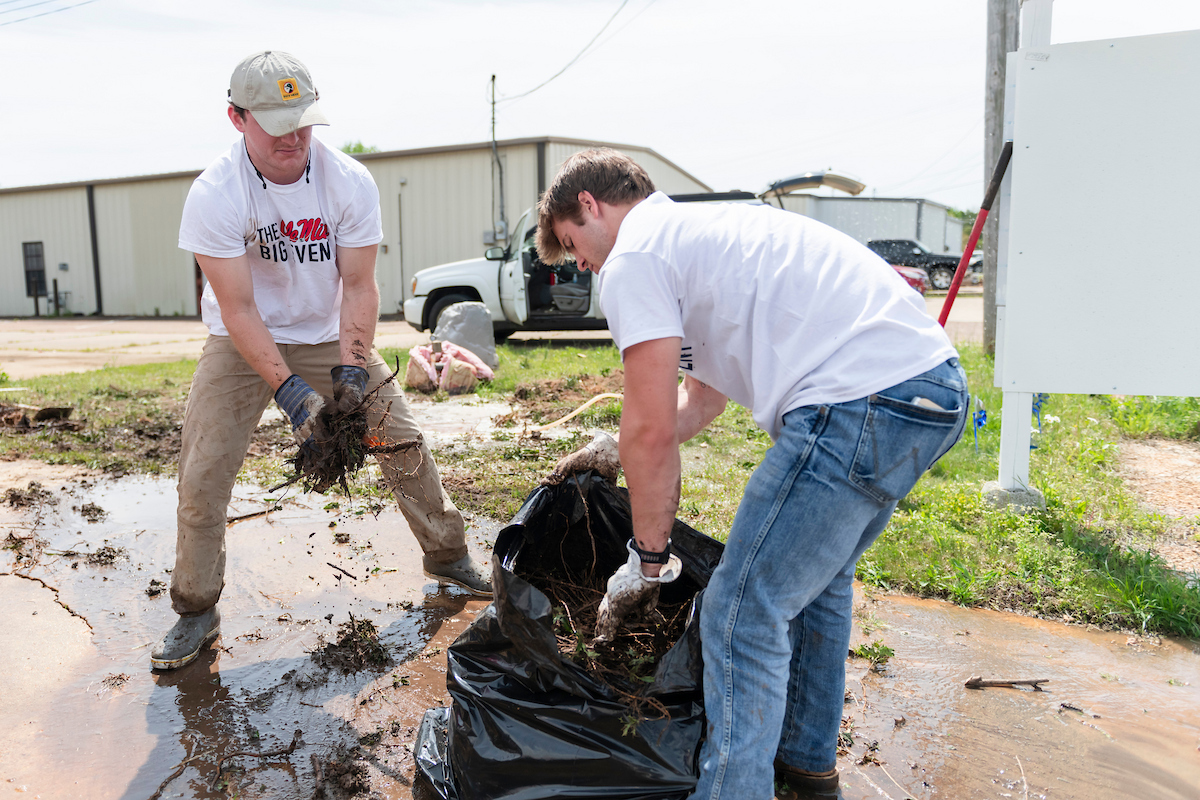Environmental Health and Safety
The mission of Environmental Health and Safety Division is to reduce the risk of illness or injury to all people at the University of Mississippi by developing, implementing, enhancing and improving programs that provide training, guidance, technical expertise and support services to all campus activities and programs, while assuring compliance with environmental regulations.
Office Location:
91 Hickory LanePhone:
662-915-5433Fax:
662-915-5480Office Hours
8:00 a.m. - 5:00 p.m.
- Home
- Departmental Directory
- Department of Facilities Management
- Environmental Health and Safety
Defining Responsibility and Authority in EHS Operations
Specific responsibilities and authority are:
- Responsibility for control and disposal of all hazardous biological and chemical substances.
- Authority to inspect all areas of the campus for violations of federal and state laws governing the safe use and disposal of all hazardous materials.
- Authority to implement controls for the use and disposal of all hazardous materials.
- Responsibility for providing safety information concerning hazardous materials to all university personnel.
Specific responsibilities and authority are:
- Responsibility for the duties assigned in the university’s Radiation Safety Manual, 2025 revised edition, and subsequent regulations imposed by MSDH under its broad license to the university.
The Department of Health and Safety will have the authority to enforce compliance with the regulations referenced in the university’s Biological, Chemical, Occupational and Radiological safety manuals and other applicable safety regulations for all segments of the Oxford campus.
- In the event of major noncompliance, action will be taken only after consultation with the Chancellor’s Office, unless there is an immediate danger to the health of personnel or an immediate danger to university property.
- Remedial actions required by this office may be appealed to the chancellor for a final decision.
- The chancellor of the university will have final authority and responsibility in these areas.
Emergency Procedures
Whenever there is an actual or imminent emergency, such as a toxic chemical release, fire or explosion, which has the potential to cause pollution of the air, land or waters of the state, and/or endanger the public health and well-being of the surrounding community, on-scene personnel will immediately contact the hazmat emergency coordinator from the Department of Environmental Health and Safety at 915-5433. After-hours calls may transfer over to personnel in the Physical Plant Dispatcher’s Office, 915-7087, who will contact an on-call responder(s) through telephone, cell phone, radio and/or pagers.
The hazmat emergency coordinator will determine whether the incident constitutes a release of a reportable quantity of hazardous material to the environment. If the incident meets a hazardous material reportable quantity requirement, or any other federally mandated reporting requirement, the hazmat emergency coordinator may direct a representative of the university to notify (as required) one or more of the following agencies:
Emergency Contact Information – Environmental Health and Safety
| Agency/Organization | Phone Number | Purpose |
|---|---|---|
| Mississippi Department of Environmental Quality | 1-601-961-5171 | Facility Releases |
| Mississippi Emergency Management Agency | 1-800-222-6362 | Non-University Materials |
| Mississippi Highway Patrol | 1-601-987-1530 | Roadway Incidents |
| Mississippi Division of Radiological Health | 1-601-987-6893 | Radiological Incidents |
| National Response Center | 1-800-424-8802 | Reportable Quantities |
| CHEMTREC | 1-800-424-9300 | Common Carriers |
| Military Shipments | 1-800-851-8061 | Military Materials |
Other Local Agencies
| Agency/Organization | Phone Number |
|---|---|
| University Police Department | 4-911 |
| Oxford Fire Department (Emergency) | 9-911 |
| Baptist Hospital / Ambulance Services | 9-911 |
Immediately identify the character, exact source, amount and extent of all released materials. If a motor vehicle is involved, check for shipping papers or other documents in the cab, note container shapes, sizes, markings, labels and placards.
Identify any personnel injuries, medical requirements and evacuation routes.
The potential for fire, soil and water contamination and the potential release of toxic fumes to neighboring areas must receive the highest priority.
The hazmat emergency coordinator will concurrently assess the possible hazards to human health or the environment that may result from the release, fire or explosion. Factors to be considered in making this assessment are as follows:
- Direct hazards due to the release:
- Presence of flammable or corrosive vapors in the building.
- Presence and character of released liquid or gas, either flammable irritant, corrosive, toxic or asphyxiating.
- Potential for involvement of other containers in the area due to heat produced in fire or corrosion of metal due to the release of an acid, gas or liquid.
- Potential for radioactive materials contamination or exposure.
- Indirect hazards due to the release:
- Effects of spill or fire upon human health and the environment.
- Effects of fire or spill control activities such as water runoff.
University personnel are instructed to treat hazardous-materials incidents as fire emergencies. Depending on the nature and amount of material spilled, evacuation would proceed in the same manner as a fire situation — people are instructed to alert neighbors and attend to victims without endangering their own lives.
Evacuation maps with exit routes indicated on them are posted in all university buildings and on the walls by every elevator.
During a hazardous-materials incident, the first police or fire officer on the scene will assume control of the situation and will become the on-scene commander. Depending upon the nature and extent of the incident, a command post may be established at the scene or in the Lyceum as necessary.
The on-scene commander will transfer his or her authority to the first staff member from the Department of Environmental Health and Safety that arrives at the incident location. All police, fire department and other involved personnel will operate under the direction of the on-scene commander.
This individual will also designate a safe location for incoming supplies and personnel, and will advise the University Police and the Physical Plant of this location. The first arriving unit(s) will isolate the area and deny entry to the public and to all nonessential personnel.
EMERGENCY AUTHORITY: During an emergency involving hazardous materials, Environmental Health and Safety personnel have the authority to commit any university resources necessary to mitigate the incident and to protect the environment.
Special containment measures are provided in areas where hazardous materials and/or hazardous waste are stored, used or processed to collect, capture or contain any spill. Environmental Health and Safety has appropriate materials to contain and clean up most laboratory-size spills and additional materials to plug and overpack container and drum leaks. During emergencies, the hazmat emergency coordinator will take all reasonable measures necessary to ensure that fires, explosions or releases do not occur, recur or spread to other wastes stored at the site, or to storm water, whenever possible and without endangering human life. These measures will consist of collecting and containing spilled material and removing or isolating containers.
- Debrief emergency personnel and civilians involved in the incident.
- Document the incident and advise individuals involved as to effects of exposure, properties of the materials, etc.
- Fire control equipment:
- Fire extinguishers – 10-pound, Class B-C portable carbon dioxide extinguishers are available in most laboratories, shops and service areas. They are mounted on walls of hallways, inside and next to the main entrance of each room or laboratory. These fire extinguishers are in compliance with National Fire Code standard for portable fire extinguishers. In the event of fire, personnel may choose to use the extinguisher if such action does not endanger their safety. Personnel are never required to attempt to fight fires.
- Flammable storage. Flammable chemicals and chemical waste are stored in flammable cabinets and/or storage rooms where secondary containment is provided.
- Spill control equipment:
- Spill response supplies are stored in the the Chemical Storage Facility and the Radiation Safety Laboratories. All supplies can be brought to an incident location in a short period of time. These supplies include acid, caustic, solvent, neutralizing, adsorbing or solidifying agents for spills ranging in size from one to 10 liters; 30-pound bags of vermiculite; 5-gallon plug and dike; spill absorbent pads, pigs and pillows; mercury decontaminating powder (Hg-X).
- Internal and external communication:
- Telephones: Most laboratories and service areas have access to telephones.
- Fire alarm pull stations are located in most hallways of building, near exit stairways of all floors.
- Personal decontamination equipment:
- All laboratories, shops and service areas where personnel use or store hazardous materials are required to have access to safety showers and eye washes.
- All areas have access to running water through sinks and hose attachments.
- Special decontamination area will be set up if necessary during emergency response to hazardous chemical spills.
- Personal protective clothing:
- Respiratory protection: Various models of half-face/full-face respirators with cartridges for organic vapors/acid gas, HEPA dust protection and self-contained breathing apparatus (SCBAs) are available for use by emergency response team members.
- Chemically resistant gloves: Silver Shield, Viton, Butyl, N-Butyl Rubber, Neoprene Heat/Cold resist, Nitrile gloves with permeation degradation resistance guides, disposable Nitrile Latex and Vinyl gloves.
- Chemically resistant clothing: Chemrel Coveralls, Chem-Tuff Coveralls, Saranex Coated Tyvek Coveralls, Chemrel Booties along with tape for sealing gloves and boots.
- Storage containers:
- 55-gallon open head high density polyethylene (HDPE) drums
- 55-gallon open head steel drums (DOT-17H)
- 30-gallon open head steel drums (DOT-17H)
- 5-gallon HDPE pails
- Polyethylene bags
- Tools and miscellaneous supplies: Various tools to aid in the cleanup of chemical spills such as brooms, dust pans, mops, buckets, shovels, scrapers, utility knives, scissors, tape, marking pens, labels and handling tongs.
- Radiation monitoring and decontamination equipment.
- Gas monitoring equipment.
Programs & Support

Safety Programs
Safety programs for Biological, Chemical, Laser, and Radiation Safety are established to protect personnel, the environment, and facilities from the potential hazards associated with the use of biological agents, hazardous chemicals, lasers, and radioactive materials.

Waste Disposal
Effective waste management is essential for maintaining a safe and environmentally responsible research environment.

Hazmat Resources
EH&S provides essential safety through safety training, spill response, hazardous materials management, and regulatory compliance. EH&S ensures adherence to EPA, DOT, MDEQ, and MSDH regulations and is the only authorized provider for hazardous material handling and disposal. Faculty, staff, and students working with hazardous or radiological materials must complete required EH&S safety training.
The EHS Team Keeping Our Campus Safe
Shane Kesler
- Director Environmental Health and Safety
Joby Murphy
- Radiation Protection Specialist
Marlania Craig Sharpe
- Staff Assistant II
Therrell Hall
- Laboratory Services Specialist
Foster Logan
- Laboratory Services
Reba Chamblee
- Environmental Health and Safety Specialist
